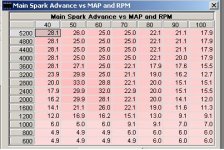Just received a copy of Tunerpro software, bin files and definition files so I can understand how the ECM is programmed on these engines. I found some programming in the fuel and timing tables that looks kind of odd. The maximum timing advance at 100kpa is only 18* above 3200 rpm's. This plus the initial 8* is only 26*. I thought these engines should have a total advance somewhere around 30*ish plus?
I also noticed that at 3600rpm's the TA drops (I'm on my Mac so I don't have the program up in front of me right now so forgive me if the numbers aren't exact) from 20ish at 3400 to 15ish at 3600 and back to up 18 above 3600rpm. Any idea why there would be a dip in the TA curve and it not be linear?
I also noticed something I was never aware of and that is the effect the engine coolant temp has on timing and fuel delivery. The ECM will demand a longer pulse width (i.e. run way richer) when the engine is not up to temperature. This mainly serves as a choke does for carb engines to deliver more fuel until it's warmed up. Until these engines are up to 140* they will burn 9% more fuel (or more) until 160* is reached. So for those that have thermostat problems and are not getting proper temps this could be one problem for more fuel burn and possibly the reason for the fuel sheen on the water.
I'm having all these problems.
I also noticed that at 3600rpm's the TA drops (I'm on my Mac so I don't have the program up in front of me right now so forgive me if the numbers aren't exact) from 20ish at 3400 to 15ish at 3600 and back to up 18 above 3600rpm. Any idea why there would be a dip in the TA curve and it not be linear?
I also noticed something I was never aware of and that is the effect the engine coolant temp has on timing and fuel delivery. The ECM will demand a longer pulse width (i.e. run way richer) when the engine is not up to temperature. This mainly serves as a choke does for carb engines to deliver more fuel until it's warmed up. Until these engines are up to 140* they will burn 9% more fuel (or more) until 160* is reached. So for those that have thermostat problems and are not getting proper temps this could be one problem for more fuel burn and possibly the reason for the fuel sheen on the water.
I'm having all these problems.


